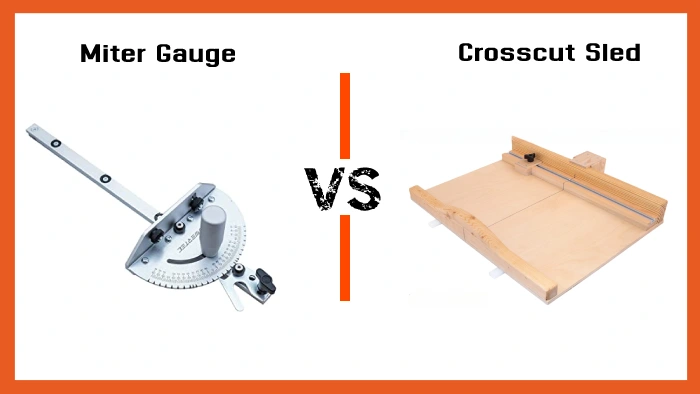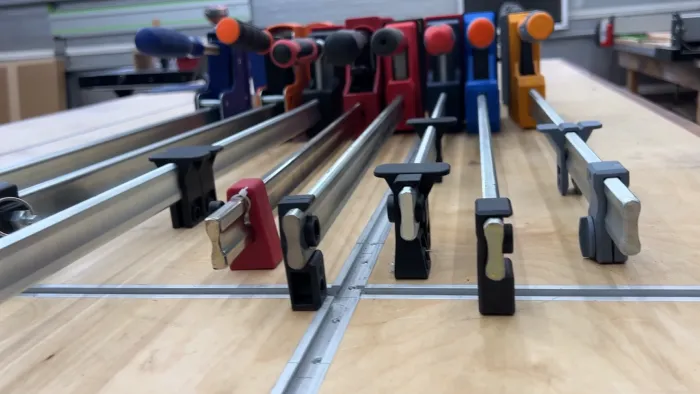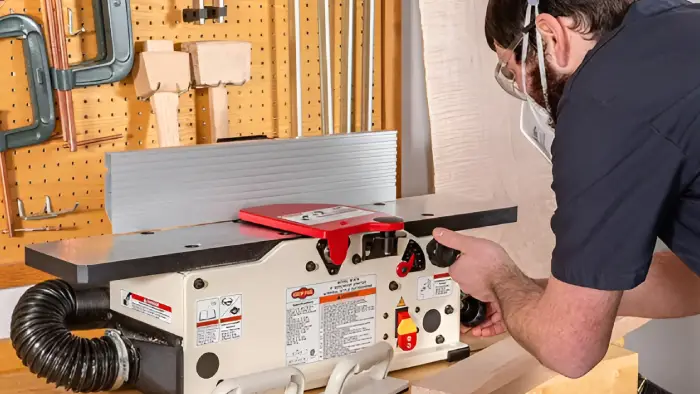WoodenuKnow.com is a participant in the Amazon Services LLC Associates Program, an affiliate advertising program designed to provide a means for sites to earn advertising fees by advertising and linking to Amazon.com and may earn from qualifying purchases.
Woodworking enthusiasts understand the significance of utilizing the appropriate tools to achieve precise and accurate cuts, which directly impacts the quality of their work.
Two essential tools in any woodworker’s arsenal are the miter gauge and crosscut sled, both instrumental in producing various cuts with remarkable precision.
While these tools may initially appear similar, their primary functions and cutting abilities significantly differ. The miter gauge, characterized by its T-shaped design, specializes in quickly creating diverse angled cuts. But, it is primarily limited to smaller workpieces due to its compact size.
Contrastingly, the crosscut sled is specifically engineered to produce impeccably straight cross cuts while accommodating a wider range of workpieces, thanks to its larger size.
If you are a beginner or an expert woodworker, you must understand these tools to make precise cuts for your projects. Keep reading to learn more about the difference between Miter Gauge and Crosscut Sled and which is perfect for your woodworking project.
Miter Gauge VS Crosscut Sled: Main Differences
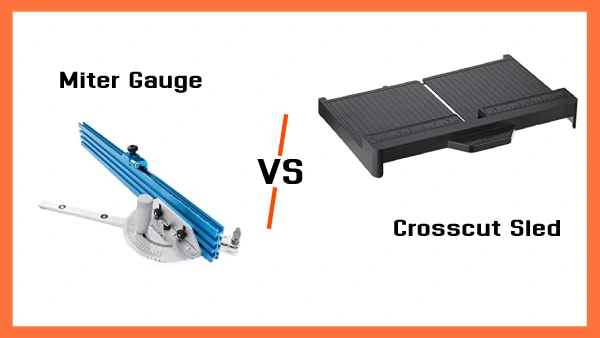
Woodworking enthusiasts often struggle to make angled or straight cuts, resulting in wasted materials and broken projects. That’s where the table saw miter gauge and crosscut sleds come into play. These tools easily make accurate cuts, but what is the difference?
Here are some key differences between these two:
Tool Purpose
One key difference between the miter gauge and the crosscut sled is their purpose. The miter gauge is primarily designed for angled cuts, while the crosscut sled is intended for straight crosscuts.
Table saw miter gauges are particularly beneficial when cutting molding, frames, and other angled projects. In contrast, a crosscut sled makes accurate square cuts without the risk of kickback.
Fence and Runners
Fence and Runners are essential to miter gauge and table saw crosscut sleds.
The fence runs perpendicular to the blade on a miter bar gauge sled and can be adjusted to different angles, providing versatility. On the contrary, the fence on a crosscut sled runs parallel to the blade and is fixed in place, ensuring a square cut.
A table saw miter gauge typically has two runners that fit into the miter gauge slot, ensuring stability during angle cutting. Conversely, a crosscut sled may have one or two runners depending on the design. These runners keep the cut straight, reduce saw blade deflection, and improve accuracy.
Tool Size and Weight
Size and weight are also significant differentiators between these two. A good miter gauge is often smaller and lighter than a crosscut sled since it is designed for making angled cuts in shorter pieces.
However, a crosscut sled is usually larger and heavier than a miter gauge since it is meant for making long and continuous straight cuts.
These tools can also cut different types of stock depending on their size and weight. A table saw miter gauge can handle smaller stock, typically 12 inches long, while a crosscut sled can handle larger stock up to 24 inches long.
Setup Time
While the setup time for a crosscut sled may be longer than a table saw miter gauge due to the need for precise alignment of the sled’s fence and runners with the blade. The benefits of enhanced accuracy and increased cutting-width capacity make the extra effort worthwhile.
But it is worth noting that miter bar gauges offer rapid setup and adjustments for varying angles, which makes them an appealing option for users who prioritize ease of use and versatility.
Ultimately, professionals and experts should carefully consider their specific needs and preferences when deciding between these two options, as each has its advantages and disadvantages.
Cutting Capacity
The cutting capacity of the two tools is another important consideration. Miter bar gauges can typically handle crosscuts up to about 12 inches wide, beyond which the gauge’s head can catch on the table edge during the cut.
In contrast, crosscut sleds offer twice the cutting-width capacity of gauges, making them the ideal choice for crosscutting wide panels. These sleds are preferred for projects involving larger workpieces or when greater cutting-width capacity is required.
Cutting Flexibility
Table saw miter gauge, offering remarkable flexibility when compared to crosscut sleds. Their ability to accommodate various cuts, including slopes and compound angles, renders them an indispensable asset for woodworkers undertaking projects requiring various angular adjustments.
By contrast, a crosscut sled’s forte lies in delivering precise and straight crosscuts, making them the go-to choice for woodworkers seeking accuracy and consistency in their cuts.
Cutting Accuracy
When achieving straight crosscuts, the crosscut sled is the clear winner. Its fixed fence and runner system ensure greater precision and accuracy than the miter gauge.
But miter gauges are more versatile and can make a wider range of angled cuts, including bevels and compound angles. Achieving the same level of accuracy with a miter gauge may require more finesse and attention to detail, especially when making angled cuts.
Depth of Cut
A sled carries the workpiece through the blade while a miter gauge pushes the stock resting on the saw’s tabletop. As a result, using a sled costs you about 3⁄4″ of the blade’s thickness capacity.
If you work with 2″ or thinner boards, this limitation is not a big deal. But for thicker materials, a miter gauge may be a better option as it allows for the full depth of cut.
Tool Versatility
Tool versatility is essential when selecting the ideal equipment for any woodworking or carpentry project. Among the options available, a miter gauge stands out due to its ability to offer a larger variety of angled cuts, such as bevels and compound angles.
This flexibility is a significant advantage compared to a crosscut sled, which is solely adept at making straight crosscuts. So, the miter gauge becomes a preferred choice for projects demanding a diverse range of cuts.
But you must note that achieving the same level of precision found in a crosscut sled may necessitate a higher degree of expertise and proficiency in working with a miter gauge. Thus, balancing versatility and accuracy is crucial when selecting the right tool for your requirements.
Which is Best for Precise Angle Cut: Miter Gauge or Crosscut Sled?
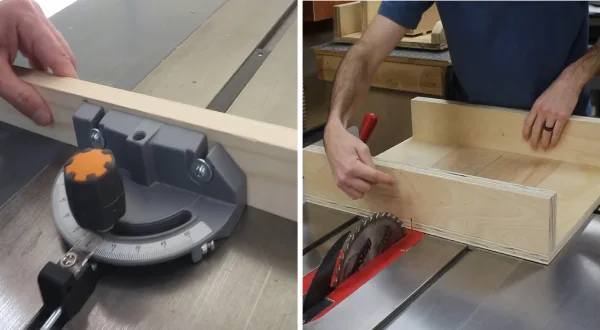
Although these tools indeed have their pros and cons, miter gauges (such as INCRA MITER V27) have positive stops for standard angles like 0°, 22.5°, 30°, and 45°, as well as additional angles for more flexibility.
This makes it easier for beginners to achieve the perfect angle without needing advanced knowledge or additional tools.
These miter gauges are also lightweight and portable, making them a convenient tool to have on hand in the workshop. However, using a miter gauge requires a steady hand and a lot of patience, as any jolts or deviations from the intended angle can lead to inaccurate cuts.
We’ve got your back if you’re searching for a reliable miter gauge. We have reviewed top-of-the-line options to ensure you get exactly what’s right for your cutting needs. You’ll find everything you need to know about the best table saw miter gauge in this post.
Can You Use a Miter Gauge as a Crosscut Sled?
Utilizing a miter gauge like a crosscut sled with your saw can be an effective method for crosscutting. But it could be less safe and accurate than employing a well-constructed crosscut sled.
One of the primary benefits of a crosscut sled is that it offers superior accuracy and smoother cuts, as it securely holds the workpiece in place while gliding along the blade path. Doing so successfully eliminates blade binding, a common hazard associated with cross-cutting using a miter gauge.
Furthermore, a crosscut sled far outstrips a miter gauge for precision in miter angle cutting, providing a significant advantage for professionals and avid woodworkers. As a result, it is highly recommended to use a dedicated crosscut sled to ensure maximum safety and accuracy during intricate cutting tasks.
Are There Any Benefits of Miter Gauges in Cross-Cutting?
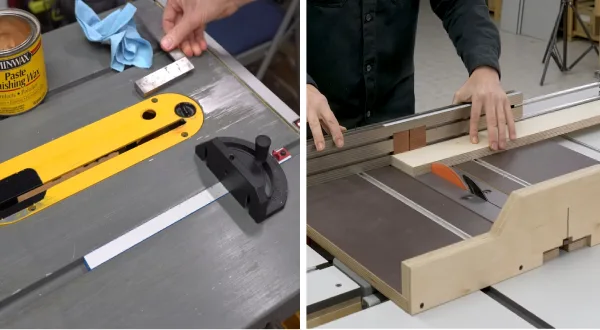
Miter gauges offer several benefits when cross-cutting. They allow you to make cross-cuts perpendicular to the grain, vital for accurately fitting components. They also enable you to make 90-degree perpendicular cuts often needed when constructing furniture and other woodworking projects.
Miter gauges are highly adjustable and can be angled to cut a workpiece at different angles. They offer excellent versatility in angled cuts, making them an indispensable tool for any skilled woodworker. With proper use and adjustment, a miter gauge can make precise and accurate cuts for any woodworking project.
Is a Crosscut Sled Necessary?
While not an essential tool for all woodworking projects, a crosscut sled is a valuable addition to a woodworker’s arsenal, as it enhances safety and precision when working with a table saw.
The crosscut sled mitigates the risk of accidents by offering a stable and secure platform for the workpiece, minimizing the likelihood of the material becoming trapped, jamming, or causing a kickback.
Furthermore, this equipment heightens the accuracy of cuts by assuring the blade remains perpendicular to the material, leading to a consistently straight and clean cut.
How Accurate is a Crosscut Sled?
A crosscut sled is a highly accurate tool used in woodworking to make precise, straight cuts at consistent angles. Revered for its exceptional accuracy, a crosscut sled can make straight cuts at steadfast angles with an astonishing precision of up to one-thousandth of an inch (0.001″).
This remarkable tool provides woodworkers with a stable and secure platform to hold the workpiece, effectively eradicating the risks of material movement or slippage during the cutting process.
Consequently, by utilizing a crosscut sled, woodworkers can attain impeccably precise cuts with absolute confidence and a minimal margin for error.
Does a Crosscut Sled Prevent Kickback?
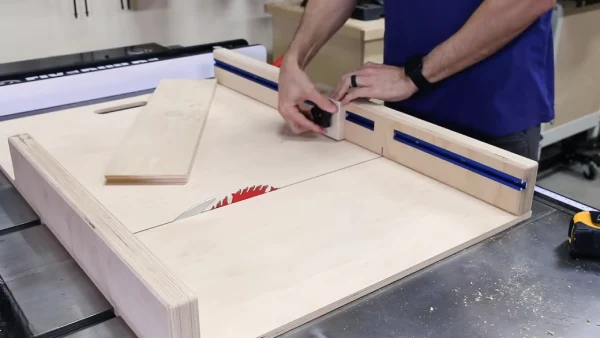
A crosscut sled significantly reduces kickback risks by providing precise orientation and support to the cut material. An unfortunate sawing hazard is a kickback, which occurs when the material being cut twists, turns, or shifts during the cutting process, causing the blade to bind and the material to fly back.
A crosscut sled minimizes this risk by securely holding the material, reducing its ability to move during the cut, and keeping the cut piece next to the sled. Hence, using a crosscut sled significantly reduces the chances of experiencing kickback.
What is the Primary Benefit of a Crosscut Sled?
The essential advantage of a crosscut sled is its ability to make repetitive cuts easy. These sleds provide a stable, guided surface that allows the operator to make repeated precise cuts. This leads to faster, more efficient work as the sled can be set up to make multiple cuts at once, maximizing workshop productivity.
Also, using the sled ensures the cuts are consistent, reducing material waste and improving the quality of the final product. It is also customizable, allowing the operator to create various angles and molds for repeated shapes, cuts, and other features.
Miter Gauge or Crosscut Sled: Choose Wisely
As a professional woodworker or a passionate enthusiast beginning your journey, embracing the essential nature of miter gauge and crosscut sled in your toolbox is crucial. These essential tools are pivotal for enhancing the precision of your cuts and contributing to a more enjoyable woodworking experience.
Being well-versed in the unique advantages offered by both tools can significantly elevate your woodworking prowess while ensuring that your project needs are impeccably met. But a fundamental understanding of their distinct functions is necessary to determine the most appropriate tool for a specific project.
So, before starting on a project, study the requirements, and judge whether you will need a crosscut or a miter gauge. Understanding the purpose of each sled is essential to determine which tool is best suited for the work you intend to do.

